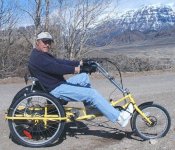I know it is a bit expensive, but I wonder if the V3 beta Cycle Analyst would be a good add on to any potential mobility device application. I made my wheel base 42" or 107cm, so my tipping point center of gravity is 21", but this is way outside of mobility device range. The narrow wheel base needed for one of these is pretty dangerous. I don't have any experience with the V3 cycle analyst, but it offers current based control over your motor, so...I wonder if it might not be a good add on for anyone thinking to electrify. Use it to find the speed you are comfortable with.
Or a nuvinci, which I have. That also allows you to program the speed you want, and the gearing allows you to keep the motor in its happy place, and...the start-ups are better.
I think fechter did some work on a circuit for current based control as well, but I am not sure about the thread location.
But whatever a person comes up with, I think they are going to want to start slow and work their way up to a comfortable spot. I am not sure that many of the motors commonly used are even necessarily the best option for a mobility device. Maybe a controller with 3-speed switching would be useful? I wonder if some of the cheaper motors used well below rating might be ok? Only problem is slow has such a heat penalty.



